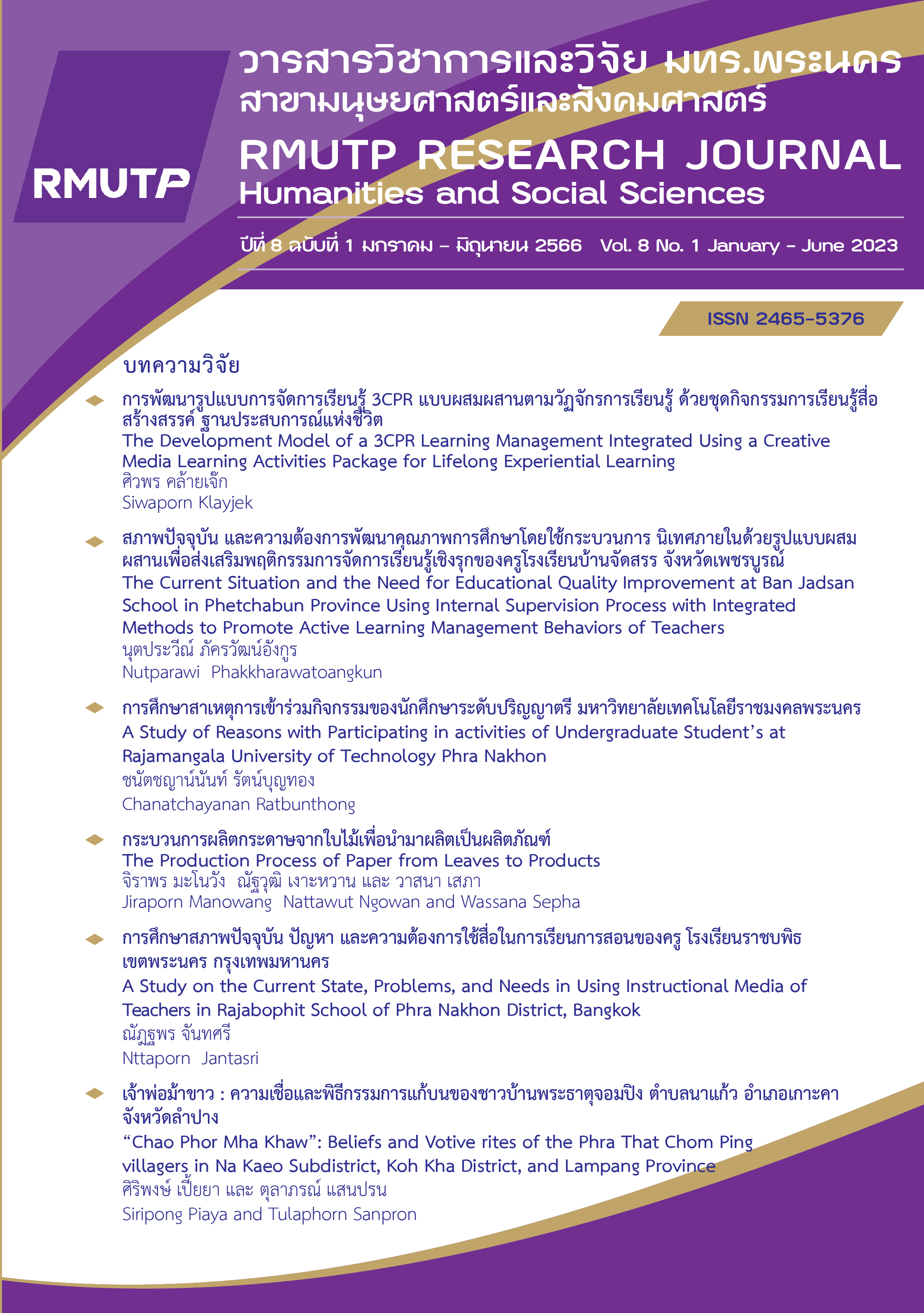The Production Process of Paper from Leaves to Products
Main Article Content
Abstract
The purposes of this research were 1) to study the suitable leaves for making paper sheets and 2) to enhance the products' value 2) to study product design and development guidelines. The methods were used to collect both monocots and dicots for a total of 10 species selected from the amount of planting and trimming the leaves to discard waste, including golden fig, rain tree, dwarf pandanus, spider lily, bullet wood, snake plant, dracaena, cordyline, yellow palm, and ducasse banana leaf. These leaves were used to test the production process of a sheet of paper by bringing it through the boiling process. The weight of each type of leaf was 250 grams; 125 grams of castic soda and 5 liters of water were boiled until the leaves were decomposed for 1-2 hours and then rinsed with clean water. Then, ladle the tissues with a sieve onto a plate, dry them, and peel the parchment from the sieve plate. The research results for the characteristics of the paper obtained from all 10 types of leaves were different. Using tactile and tensile methods, it was found that the surface was rough, airy, soft, smooth, and had a lot of fiber toughness. The number of fibers was greater than that of tissues, making the paper uneven. In addition, the researcher selected three types of paper by testing their water permeability and general physical characteristics, namely, paper made from snake plant leaves with airy fibers, paper made from banana leaves with smooth surfaces, and paper made from spider lily leaves with a soft touch. Therefore, the three types of leaves mentioned above were designed as prototypes. For example, a lamp made from snake plant leaves costs 270 baht, a 6 x 8-inch picture frame made from banana leaves costs 199 baht, and a 3.5 x 4.5 x 1-inch souvenir box made from spider lily leaves costs 50 baht. These products were not only fallen leaves and waste, but they could also generate income for those who were interested in learning more.
Article Details
References
จันทิมา ชั่งสิริพร, พฤกระยา พงศ์ยี่หล้า และนิรณษ ชัยฤกษ์. (2565). การผลิตบรรจุภัณฑ์เยื่อกระดาษขึ้นรูปจากฟางข้าวและชานอ้อยโดยใช้ไคโตซานเคลือบผิว. วารสารวิทยาศาสตร์บูรพา, 27(1), 20-30.
วรวรรณ สังแก้ว. (2550). การนำวัสดุเหลือใช้จากกระบวนการผลิตเสื่อกกเพื่อผลิตกระดาษกก : การสร้างนวัตกรรมและการถ่ายทอดเทคโนโลยี. รายงานการวิจัยฉบับสมบูรณ์ มหาวิทยาลัยราชภัฏรำไพพรรณี.
วรวรรณ สังแก้ว, วศิน ยุวนะเตมีย์ และคณิสร ล้อมเมตตา. (2559). การพัฒนาผลิตกระดาษและผลิตภัณฑ์กระดาษจากไส้กกร่วมกับการใช้สีย้อมธรรมชาติ. วารสารวิจัยรำไพรพรรณี, 10(4), 5-13.
วรินธร บุญยะโรจน์. (2559). การผลิตกระดาษทำมือจากหญ้าชันกาด. รายงานการวิจัยฉบับสมบูรณ์ คณะวิทยาศาสตร์และเทคโนโลยี มหาวิทยาลัยราชมงคลพระนคร.
วาสนา เจริญวิเชียรฉาย. (2551). การออกแบบและพัฒนาผลิตภัณฑ์ชุมชนประเภทผลิตภัณฑ์จากกระดาษสา กระดาษสับปะรด และกระดาษตะขบ. รายงานการวิจัยฉบับสมบูรณ์ คณะศิลปกรรมศาสตร์ มหาวิทยาลัยเทคโนโลยีราชมงคลธัญบุรี.
สำนักหอสมุดแห่งชาติ. (2563). นวัตกรรมการใช้กระดาษสาเพื่อพัฒนางานด้านการอนุรักษ์เอกสารและหนังสือของห้องสมุดแห่งชาติ. กรุงเทพฯ: สำนักพิมพ์คณะรัฐมนตรีและราชกิจจานุเบกษา.
สุทธิสาร อนันตรัตนชัย และรําพึง เจริญยศ. (2556). การผลิตกระดาษจากต้นธูปฤาษีด้วยเครื่องอัตโนมัติ. รายงานการวิจัยฉบับสมบูรณ์ คณะวิศวกรรมศาสตร์และสถาปัตยกรรมศาสตร์ มหาวิทยาลัยเทคโนโลยีราชมงคลสุวรรณภูมิ.


